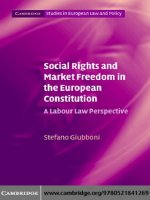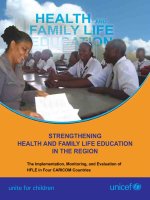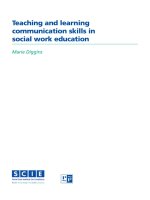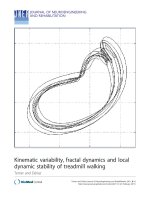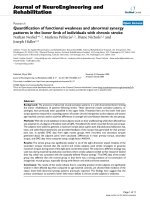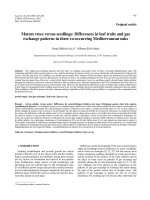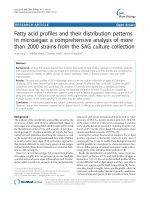Social dynamics and local trading patterns in bantaeng region, south sulawesi (indonesia) circa 17th century 4
Bạn đang xem bản rút gọn của tài liệu. Xem và tải ngay bản đầy đủ của tài liệu tại đây (5.09 MB, 54 trang )
174
Chapter 4
Contemporary Bantaeng:
Alternative Models of Economic Activity
1. Ethnographic Data on Trading Activity in the Bantaeng Region
Bantaeng inhabitants can be divided into two groups: locally-born people, and people
who are posted to Bantaeng from elsewhere because of work. The second group mostly
lives in Bantaeng city as administrative offices are located in Bantaeng city, and they have
become a ‘new elite group’. The new elite has regular income, both rice and cash, while the
local people have products which can be exchanged for cash—which is needed for such
purposes connected with the modern economy as buying imported goods, paying school
tuition, daily transportation for their children, and paying electricity bills. The consumption
patterns of new elite groups (immigrants) are dependent on complimentary relationships
with producer groups (locally-born people). Local people cultivate land and collect sea
products which the newcomers have to buy with cash. The elite group obtains vegetables by
cooperating with local people who collect it for them in land acquired by the immigrants.
This leads to certain forms of transactions. The factors stimulating the flow of people to
trading centers can be observed. People are not only buying for individual consumers but
also buying in order to resell to other people in other trading centers.
Almost all manufactured products are produced outside of Sulawesi. They arrive by
ship in Makassar city harbor, and then are distributed by land to trading places in south
Sulawesi, including Bantaeng. However, some local crafts are distributed within Sulawesi.
175
There is no craft activity in Bantaeng except house building. Earthenware vessels, which are
still an integral part of daily life for both immigrants and local-born, come from Takalar and
Bulukumba. Iron tools come from Sinjai, mats from Takalar. Tobacco comes from Sinjai
while salt comes from Jeneponto. The goods will reach both coastal and hinterland areas by
land transportation, which is cheaper than sea transport and because Bantaeng has no us-
able cargo facilities.
Local people of Bantaeng are mainly self-sufficient, producing for their consumption. Lower
status people of Bantaeng mostly work for other people—both local ‘old’ elite groups and ‘new’
elite who were able to buy land. Some members of lower-level groups are self-employed but
their landholdings are universally small, and the harvest of food crops rarely produces any sur-
plus. Production is irregular and seasonal.
Nine major cash crops are produced in Bantaeng: cocoa, cloves, coffee, corn, candle-
nuts, cassava, kapok, vegetables, and banana. These products are grown in four different
districts: cocoa, cloves, coffee and banana come from several places in Tompobulu and
Eremerasa Districts; corn is grown in almost all districts in the region, but especially in the
elevated areas and on the flat areas during the dry season; and candlenuts come from the
Onto area of Bantaeng District. These cash crops are collected in Bantaeng city and then
taken by truck to Makassar city as land transportation is cheaper than by sea, and Bantaeng
harbor is only adequate for fishing prau, the same as Bulukumba and Jeneponto harbors.
The transport of local certain commodities from Bantaeng to Makassar may be said to
approximate more closely the dendritic model. However, there are some complications in
applying the model, because some highland commodities travel from third-tier producing
areas to second-tier collecting centers to Bantaeng city, whereas others bypass the second-
176
tier centers and flow direct to Makassar. This does not accord with the concept of the
dendritic system in which producers only have one choice of a market for their produce, and
hence are under the control of a monopolistic system. Makassar is a first-tier place for
South Sulawesi, but a second-tier place in the Indonesian system, with most of its produce
going to Surabaya. On the other hand, Makassar also has sea links to other ports as well,
rather than being monopolized by one overseas trading partner. Thus the question of whether
a system is dendritic or not is not a simple yes-or-no question; one can speak of degrees of
freedom, of relative concentrations of power in the overseas trading partners, in which
relations of collaboration, price-fixing among consortia of middlemen, and other factors
combine to undermine the simple application of ideal marketing principles to any situation.
Local people sometimes come to market to sell their crops in order to buy other
goods they need. This type of trader usually brings products in small quantities, and often
177
just a single commodity. The goods are usually harvested from rainfed field, ladang, or
household yard, such as fruits including langsat, banana, and jackfruit, vegetables, rice,
cassava, peanuts, pumpkin, and corn. In Bantaeng there are markets in villages, near the
subdistrict capitals, and in the regency capitals. The population uses the markets to ex-
change their produce with one another in order to fulfill daily subsistence needs.
The local marketing system in south Sulawesi is hierarchical, with Makassar city the
highest-order the central place and the rest of Bantaeng the periphery or a set of lower-tier
markets. On the provincial level, there are five tiers, and on the national level there are six
levels. Bantaeng city would be a second-tier center on a provincial level, with regency
markets a third-tier, INPRES markets level a fourth-tier, and village markets a fifth-tier.
Makassar is the main entry point for articles from Java and eastern Indonesia. Local com-
modities flow to local markets and also to Makassar city, and manufactured products from
Java are distributed from Makassar city to second-tier markets, and then redistributed to
local trading centers and warungs (small shops/kiosks). Central place theory applies better
to some aspects of the marketing pattern, and dendritic models better explain other aspects
of it. Makassar city is a central market for exporting local commodities (such as coffee,
cocoa, and clove) by land and sea, and a lower-tier market in a system for distributing
goods from Java to Sulawesi.
Sixteen trading markets supply Bantaeng people. In the Bantaeng marketing net-
work, the Bantaeng Central Market (Pasar Sentral), in addition to being a 2
nd
level market
after Makassar, is a first level market for Bantaeng itself. INPRES markets (Pasar Inpres)
serve as 2
nd
level markets in Bantaeng, and village markets are the 3
rd
level. Some markets
have permanent structures. Such markets are here labelled level 2b, whereas markets of
178
type 2a are pasar INPRES. Some village markets are very crowded, others less so. These
can therefore be divided into 3a (busier) and 3b (less). “Spontaneous” markets not estab-
lished in a permanent location are fourth-level. However local people still remember there
were market which located in their village.
Markets in Bantaeng are always located near rivers. In coastal areas, markets are
near the river mouths, while hinterland markets are located at junctions of tributaries. The
hinterland trading centers are associated with intersections along the asphalt road and Salo
and Balong type of rivers.
This indicates that the trading centers in the hinterland are not in steep and elevated
areas. Residents in flat regions can reach markets more easily than those in hilly areas.
Residents in isolated hilly regions go to markets by walking or pack horses, while those
along roads use public transport. Interviews with hinterland dwellers indicate that the maxi-
mum walking time from home to market is two hours. Those who use public transport
179
reported a maximum travel time of 30 minutes and a maximum cost of Rp. 1000 (S$ twenty
cents).
Viewing Bantaeng as the region under study, the highest level trading center is located
at Bantaeng city, the Regency capital. This first-tier market was built by the local govern-
ment. The central market of Bantaeng is located close to the colonial-period administrative
center and is an expansion of the Old Market which was formed before government regu-
lation.
Markets in 2
nd
tier are generally located at strategic locations near government ad-
ministrative offices such as the Kantor Kecamatan (district capital), Kantor Kelurahan
(sub-district capital), PUSKESMAS (Community Health Center), and local schools—as
seen for INPRES markets Loka and Banyorang until 1999. The Bantaeng regional govern-
ment renovated and enlarged Lambocca village market which until the early 1990s was very
popular. The Pasar INPRESS Lamboca is located on the main road which connects Bantaeng
No Name of the Market Level Opening day Location
1 Pasar Sentral dan Pasar lama 1
st
tier everyday coast
2 Pasar Kallamassang
(INPRES)
2a tier Monday, Thursday coast
3 Pasar Lambocca (INPRES) 2a tier Saturday night, Sunday,
Wednesday night Thursday,
coast
4 Pasar Banyorang (INPRES) 2a tier Sunday, Tuesday night,
Wednesday, Saturday night
inland
5 Pasar Loka (INPRES) 2a tier Monday, Thursday inland
6 Pasar Panaikang 3
b tier everyday coast
7 Pasar Campaga LoE 3
b tier Monday, Thursday inland
8 Pasar Dapoko 3
b tier Tuesday, Saturday inland
9 Pasar Layoa (INPRES) 2 a tier Tuesday, Saturday inland
10 PasarMoti 3
b tier Sunday, Thursday inland
11 Pasar Dampang 4
th
tier everyday inland
12 Pasar Jannayya/Barua 3
a tier Tuesday, Friday inland
13 Pasar Parang 3
b tier Sunday, Wednesday inland
14 Pasar Bunglowe 3
a tier Sunday, Wednesday inland
15 Pasar BaroE 3
b tier Monday, Thursday inland
16 Pasar Spontaneous 4
th
tier seasonal coast
Table 2: Market in Bantaeng region
180
city to Bulukumba. The growth of the Kecamatan in late 2000 caused the Layoa village
market to be upgraded to a pasar INPRES, so that the old pattern according to which pasar
INPRES were always associated with the office of the kecamatan, local health center, and
school no longer applied. Geographically, those centers are located at the intersection of
roads and rivers. Moreover, they are always located on asphalt roads. Village markets are
also usually associated with rivers and asphalt roads, but are often in the centers of villages
rather than at intersections. The market places generally continue to use village names, such
as Pasar Loka in Loka village, BaroE in BaroE village, Pasar Bunglowe in Bunglowe village,
and Pasar Moti at Moti village.
The Pasar Sentral is open from morning to afternoon and contains a wide range of
goods. Markets at the 2
nd
a and b and 3
rd
a and b levels open twice a week. Markets on
level 2
a are larger and have permanent structures, markets of type 2b are village markets to
181
which permanent sheds have been added, whereas markets on the 3
rd
level open twice a
week, and have semi-permanent (wooden) structures. Markets of type 3a are more crowded
than those of type 3b. In Bantaeng region, three trading centers open daily but others open
twice a week. The conception of two market days a week for trading centers in Bantaeng
differentiates the Bantaeng local system from a typical central place marketing system. It is
also different from Java, for example, where there is a five-day market week system. The
Bantaeng local economic system can be analyzed to see whether the central place model
explains the Bantaeng local economic system, and if so, what kind of central place model
applied in Bantaeng.
In the hinterland, there are three markets on level 2a: Banyorang on the east, Loka on
the west, and Layoa southeast of Bantaeng. Level 2b trading centers in Bantaeng’s hinterand
are pasar Campaga LoE and Jannayya, and village markets consist of Bullowe, Dapoko,
Parang, BaroE, and Moti. Dampang market has fallen from the 3
rd
level to a mere warung
or stall. Along the Bantaeng coast, markets belong to different levels—Kallamassang,
Lambocca belong to level 2a because they are pasar INPRES, whereas pasar Panaikang is
level 3 and pasar Sentral is the first-tier market for all Bantaeng.
In the markets, local and non local people come together. Some local residents bring
cash to the market, but many bring commodities to sell or barter before they purchase their
own needs. Local people are seasonal traders. They do not bring large quantities of goods,
partly because of transportation difficulties. Their local commodities are usually purchased
by middlemen who take them to larger collection centers in Bantaeng city. Non-local people
are dealers in non-local articles. Some have stalls in pasar Sentral, and also stalls in lower-
level markets. Usually these merchants after dealing in the lower level trading center return
182
to trade in their stalls in
Pasar Sentral. Other
non-local merchants have
small capital and only sell
imported items from mar-
ket to market. A third
group constitute those
who go from village to
village hawking their wares. Traders from Bantaeng city and other parts of south Sulawesi
usually sell their products at local periodic markets in the Bantaeng region using local public
transportation or rented trucks. The traders come early in the morning or in some trading
centers they arrive a night before the opening day and stay overnight at the trading centers.
The flow of people is mostly based on the cycle of trading center opening days.
Public transportation from Bantaeng city in the early morning congregates at open markets,
but after 11 am, public vehicles resume their normal route and schedule. Markets on 1
st
, 2
nd
and 3
rd
levels within Bantaeng are
connected in a sort of web of in-
terrelations. The merchants nor-
mally sell their goods in more than
one market in Bantaeng. Mer-
chants who have stalls in Pasar
Sentral open their kiosks, then go
sell some of their articles in 2
nd
Figure 45: Women and children taking part in the bustling
activities of central market place in Parang, Bantaeng Region.
Figure 46: Traders in Parang market conduct their
activities on the open field
183
and 3
rd
level markets from morning to mid-day. Then they return to pasar sentral to sell the
remaining goods. These merchants also endeavor to purchase local commodities to sell in
pasar sentral. Merchants who do not have stalls in pasar sentral normally only visit three or
four markets per week, because they have personal relations with people in those markets.
Roving peddlers who go from village to village selling earthenware pottery and mats also
take advantage of market days. They plan their travels to optimize markets.
The local people prefer to visit trading centers which can be reached in a maximum
two-hour walk
1
(and sometimes on horseback). Some people take low-cost public trans-
portation (between Rp 500 to Rp 1,000 for one trip in year 2000) (equivalent to S$ 0.10 to
S$ 0.20). This amount of money is considerable for the rural dwellers of Bantaeng. But in
some areas public transportation is not available. People who live in rural areas in the inte-
rior mostly travel to the trading centers on foot while some people use horses to transport
bulky commodities. During market day, people concentrate in trading centers between 5 am
to 11 am.
Bulky goods are carried in a sack, whereas small quantities of goods are put in small
containers and bags. If they use public transportation or rented trucks, they put bulky stuffs
and other goods in the vehicles, but if coming on foot, they carry the goods on their heads,
by pikul (using a piece of wood to carry the stuff on their shoulders), in their hands, or on
their back. If they have horses, they put the goods on them. Sometimes goods are distrib-
uted in simple containers, such as bamboo or cloth. Goods are exchanged at the trading
centers—at the permanent and non- permanent buildings and in the open space between
1
Farmers also walk a maximum of two hours to their cultivation land. If their land is further than
two hour’s walk, they will stay temporary at their land, but have a permanent house in the village.
184
the buildings, but sometimes spontaneously outside the trading centers. Thus many actors
distribute goods freely and in varied ways.
Coastal people mostly go to coastal markets; interior people who live between 25 m
to 500 m ASL travel to surrounding market places, but the inhabitants living in the higher
locations must travel to trading centers located at lower elevations as most of the market
places in hinterland Bantaeng are located in these places. Public transportation is available
for the lower and higher elevation settlements especially from Bantaeng to Lambocca but
public transportation from Bantaeng to Loka (in two routes—see map transportation net-
work within Bantaeng region), to Onto, and to Moti is not available anytime. This forces
people to use private transportation, on foot or riding horses.
Different markets serve western, central, eastern, and coastal Bantaeng every day.
People in Bantaeng normally trade at the nearest market, but if there is something special
they may visit more distant trading centers—
1
st
or 2
nd
type of trading centers. Rural
dwellers also may sell their produce either
in markets or to middlemen who come to
their houses, or directly to buyers in
Bantaeng. Thus, although there is a hierar-
chy of markets in Bantaeng city, the exist-
ence of public transport prevents a purely
dendritic pattern from developing. This may
be a recent development. Based on inter-
views with rural dwellers, before 1999 they
Figure 47: Numerous people traverse this
road to get to the Parang market.
185
were dependent on the market nearest their residence, and commodities bought in the lower-
level market would be taken by the collectors to the market on the next highest level.
On Sundays many people go to Bunglowe, Parang, Banyorang and Boro trading
centers to buy and sell local products as well as to buy non-local products. On Mondays,
people mostly go to Lambocca trading center on the eastern coast of Bantaeng region, as
this INPRES trading center is known as a comprehensive and varied trading center with the
cheapest prices.
People from Labbo located in the north of Bantaeng, and Moti in the northeast of
Bantaeng, take public transportation to the Lambocca trading center for better quality and
prices. In some cases people have to walk more than 30 minutes to the transport point.
People from Bantaeng city have two choices of where to shop, either in Sentral trading
center (and Pasar Lama) or in Lambocca trading center. If they want to buy in bulk, they
prefer to buy in Lambocca, but if they do not have time, especially after 10 am, they will go
to Sentral market. This situation is similar on Thursday mornings, the other opening day for
Lambocca trading centers.
Figure 48: There are three
means of transportation in
Bantaeng: on foot, by horse,
and via public buses.
186
In the interior, three trading centers open on Monday mornings: Loka, Campaga
LoE, and BaroE. People from districts surrounding Loka, such as Sinowa, Borongtanga
(Bunglowe), Lanying, and Boro (Jeneponto Regency), trade in Loka.
2
Sometimes a middle-
man trader from Bantaeng city comes to buy vegetables at Loka, as this area is well known
for its production of such vegetables as potatoes, cabbages, and carrots. People who live in
the adjacent area, including people from Jeneponto, as Campaga LoE is located on the
border between Bantaeng and Jeneponto Regencies, use Campaga LoE market. People
who live in Eremerasa district use BaroE trading centers. A similar trading pattern takes
places on Thursdays. However, there is no evidence that people who live in nearby Loka
trade at either BaroE nor Campaga LoE or vice versa. This implies that geographical con-
ditions do affect their trading patterns.
2
In reverse, people from Loka and Sinowa areas come to trade in Boro Market every Wednesday
and Sunday.
187
Centers of trading activity during Tuesday and Saturday mornings are located at
Dapoko, Barua (Jannayya), and Moti trading centers. People who live near Dapoko trad-
ing center will trade there, whereas Barua (Jannayya) trading center is visited by people
from as far away as Dampang and Kampung Baru. People from Moti and Layoa areas
trade in Layoa trading center on Tuesday morning.
On Tuesday evenings, people around Banyorang and sometimes even from Bantaeng
city go to the Banyorang trading center in order to get an early bird chance to buy before the
opening next morning of the regular Banyorang trading center. This trading activity takes
place while the traders are unloading their goods.
3
Aspects of the central place model may
be seen in this system. The K-3 pattern seems most applicable in the east and west areas of
Bantaeng. Whereas central central part of Bantaeng only has access to 3
rd
level and 1
st
level
trading centers, so that the K-2 model is applicable there. For those in west and east
3
This situation also occurs in Lambocca, a day before the opening market day.
188
Bantaeng, the K-3 model is most probable, because with village markets, pasar INPRES,
and pasar sentral, they can choose among several alternatives. The range of choices is
however affected by the periodic nature of lower-tier markets. Thus a person may choose
whether to go further to a higher-level market, or wait for the local market day. The den-
dritic model seems to account for the system of acquiring local commodities by collectors in
markets.
On Wednesdays, markets are held in Banyorang in Kecamatan Tompobulu, Parang
in Eremerasa district, and Bullowe in Bissapu district. People from as far as BaroE, Dapoko,
and surrounding areas visit Parang market. Bunglowe is visited by people from Campaga
LoE and further away. Boro market in Jeneponto regency opens on Wednesday so Loka
and sometimes Sinowa people shop at the Boro trading center. This pattern shows that
administrative boundaries do not affect trading activity, but geographical boundaries do
189
influence trading patterns. This is the result of provincial roads which connect regencies.
Provincial roads are generally wider than regency roads.
On Thursdays, in addition to Lambocca, CampagaloE, and Loka, there are market
days at Moti, Kallamassang and BaroE. Trade in the coastal area is served by Lambocca
and Kallamassang trading centers.
Trade in the western hinterland is served by Campaga LoE and Loka, while the
eastern hinterland is served by Moti and the north area is served by BaroE trading center.
People from Layoa, Barua, and Borong Kapala visit Moti trading center, whereas people
nearby and from Parang areas patronize BaroE. The Moti market is also open on Sundays,
while Kallamassang also opens on Monday.
190
The settlements in eastern Bantaeng are linear in type, so the only trading centers they
can attend are those two sites, or Pasar Sentral in Bulukumba Regency. The linear settle-
ment pattern is correlated with a dendritic market system. In Pasar Loka dan Banyorang,
the central place model is clearly exemplified, because people from around Loka and
Banyorang go in crowds to this pasar INPRES. Articles from lower level markets surround-
ing Loka and Banyorang are sold in this market, and when the market closes, the remaining
items are sold at lower level markets. An exception is that good-quality vegetables from
Pasar Loka will be sent to places beyond Bantaeng, whereas lower quality vegetables will
be sold within Bantaeng. This situation is in contrast to Banyorang, because this market
contains a wide variety of articles, not as specialized as Loka.
The coastal trading centers are mostly used by people in coastal villages and, in some
cases, Bantaeng city people. The Lamboca market has been popular since it was renovated
to become a pasar INPRES. Nevertheless, Lambocca trading center is also famous among
the interior people because it is cheaper and more varied than Pasar Sentral-Pasar Lama.
The Lambocca market will be particularly crowded during public holidays because Bantaeng
city citizens, who are officials, prefer to shop at this market, which opens on weekdays.
Lambocca is thought to have been the market for the chiefdom of Lembang Gantarangkeke-
Gantarangkeke, because this market is in the upper reaches of the river of Lembang
Gantarangkeke-Gantarangkeke This market may have been an entry point for articles im-
ported from outside, so that it was once a level A market in competition with A* at Pasar
Lama, and A** at Bulukumba. However, now pasar Lambocca is only a 2
nd
level trading
center because the administrative center has moved to Bantaeng city. The dendritic model
which once existed at pasar Lambocca has shifted to central place model.
191
At Lambocca, like Banyorang trading center in the interior, unofficial trading takes
place the night before the actual opening day. On Saturday evening people conduct pre-
market trade in Lambocca, while on Sunday evening people trade before the official open-
ing in Lambocca. This means Bantaeng city people are able to trade after their work hours.
This situation is also found in other trading centers in Indonesia, such as in Imogiri market
(south of Yogyakarta), Pasar Kranggan, Pasar Gede (in Yogyakarta, Surakarta, Cirebon),
Pasar Turi in Surabaya, Pasar Jatinegara, Pasar Induk Kramat Jati (Jakarta) and other
trading centers in Java.
However, there are other trading centers which open daily. Every morning people can
be seen moving toward Panaikang (in the west part of Bantaeng), Sentral and Lama trading
centers in the Bantaeng city and Dampang trading center. The flow of people from villages
adjacent to a daily market is not as great as the flow of people towards twice weekly
markets. Like Pasar Sentral-Pasar Lama, Pasar Dampang opens from morning to evening—
192
as the sellers have built kiosks, like shophouses—so people are freer to shop. However,
people who shop in Pasar Panaikang have to shop early morning because this trading center
closes at around 9 am.
The existence of these trading centers relates to the flow of people to trading centers.
It can be inferred that these markets were once periodic markets, and changed to daily
markets later. This probably happened when people were not self-sufficient anymore. This
shift possibly occurred in the post independence period, when more people began to work
in government offices. This new elite social group, which formed between 1945 and the
1960s, did not have land to cultivate, and mostly they accept cash for their salary. Thus
people in the regency capital depended on cash. People had to buy groceries everyday, as
personal observation during field work, at that period there was no refrigeration.
In contrast trading centers, which open twice a week, are more crowded than trading
centers which open daily. Both parties try to obtain as much ‘profit’ as they can: buyers will
193
have more choices both in quantity and quality of commodities, while sellers will have more
opportunities to sell commodities and compete with other traders. Traders and buyers try to
reach trading centers as soon as possible, which benefit public transport operators. Public
transportation is only available for the days the market is open, especially during morning
hours, which creates difficulties for students and other regular travelers.
The distribution of goods within a village depends on the villagers themselves. Some-
times a village has one or more kiosks (warung). These kiosks are owned by local people
so they may informally be open 24 hours a
day, even though the formal activity is from
9 am until 9 pm every day, which enables
villagers who do not have a kiosk in their
village to obtain goods from other villages
nearby.
These kiosks supply daily needs for
people before the opening of markets. Some kiosks
are simple, with a range of fewer than ten types of
goods and the inventory of each type totaling fewer
than five items. Most of their goods are soap, deter-
gent, cigarettes, soy sauce, matches, pens, pencils,
and notebooks. Kiosks then acts as gateway of non-
local products which are ready to support local
people, however in small quantity. The distribution of
Figure 49: A warung located at Sinowa area.
Figure 50: A close-up view of the
shop showing the string-up
packets of snacks for sale.
194
such goods reaches into the peripheral
areas in the Bantaeng region, traded not
only by outsiders but also by local
people.
However, trading activity before
the actual opening day is not usual in
Bantaeng where trading normally takes
place from 5 am-10 am. In Nusa Tenggara Timur, even though traders and commodities
arrive earlier than the opening hours, they are not allowed to trade early. The situation in
Bantaeng has the unusual characteristic that there are four types of markets: from 5 am to 7
am, from 5 am to 10 am; from 6 am to 5 pm, and from 4 pm to 10 am the next day. Thus
traders are freely permitted to come and to trade before and after the actual market trading
hours.
Markets in Bantaeng can be divided into several types daily and periodic markets;
markets with different opening hours; markets in coasts and hinterlands; markets with a
wide range of goods versus markets with a few types of goods; markets with many full-time
traders/part-time traders; and market with permanent and non permanent stalls.
Ethnographic data shows that traders from many areas distribute goods to Bantaeng
region. There are traders who have stalls at the market, commuter traders and people who
sell their crops themselves. The latter is called a part-time trader as people keep most of
their share of the harvest for daily consumption and sell what they can spare for cash for
purchasing their daily needs. The stall traders mostly live in the urban area and come twice
Figure 51: A detailed image of the goods sold in
the warung.
195
a week to the markets at the opening hours. Outside the opening hours, they conduct their
trading activities at Pasar Sentral-Pasar Lama in Bantaeng city.
The traders who have stalls and commuter traders have more capital than others.
They sell manufactured products, which come from Makassar city or from Java (either from
Jakarta or Surabaya). The commodities they sell are mostly cloth, bags, and shoes. While
the commuter traders do not have stalls in trading centers, they will have special spaces. The
commuter traders are not only from Bantaeng city, but also from many places, such as
Sinjai, Bulukumba, Jeneponto, and Makassar, so they belong to different ethnic groups,
including Javanese. The commodities they sell include manufactured goods, traditional to-
bacco, iron tools, earthenware, and non-traditional food and drink. Dried and salted sea
products come especially from Jeneponto by land, as Bantaeng does not produce salted or
dried fish in quantity. Usually this type of trader stays temporarily in Bantaeng city—espe-
cially with family or people who came from similar areas, so they can move from one trading
center to another. However, they only travel to the central and eastern parts of Bantaeng, as
public transportation to Campaga LoE and Loka is unreliable.
The traders who do not have
stalls will locate themselves in the trad-
ing area, both in the space between
two shops, beside the road, or at the
front and back of the markets, or walk
around carrying their commodity in
their hands. They join similar com-
modity sellers, such as tobacco, cloth,
Figure 52: The Banyorang market is a scene of the
bustle and hustle as people conduct trade with one
another
196
iron tools, and earthenware. This type of trader differs from the part-time traders, because
they offer bargaining and extra goods if the buyers buy many items. However, these traders
move not only within one region but also to other regencies.
Part-time traders are local people who bring local products—their harvest—to the
trading centers to exchange for cash. The people of the interior who live in fertile areas
cultivate rice, vegetables, and banana while people with less fertile land plant cassava, corn,
and peanuts. Other cash crops are cocoa, coffee, candlenuts, fruits, and coconuts. The
choice of crops for cultivation is also related to elevation above sea level. The quantities of
these agricultural products sold at the trading centers are small, and seasonal.
In Bantaeng, women and their children bring chiken, fruits, palawija, and ground
coffee in small quantities, whereas men bring heavy crops such as a sack of corn, squash or
banana. The majority of the surplus is sold to middlemen—tengkulak. In the market they
occupy different areas, as women are associated with vegetables and men seldom enter this
area. The male area is in the back or on the other side of the market, where they can get
tobacco and other goods for which males are the main consumers.
Figure 53: Iron tools trader and buyer in
Banyorang market.
Figure 54: A tobacco seller is surrounded by
a group of men as they take relaxing smoke
and haggle over the price, Parang Market.
197
The relations between coast and hinterland are mainly exchanges of subsistence items.
With the availability of Pasar Sentral-Pasar Lama, which opens daily, the coastal people can
purchase their needs at these places. However, the hinterland people still consume sea
products from the traders—not the Bantaeng coastal people, but tengkulak who obtain
sea products from juragan (Boss; investor). The exchange between coastal and hinterland
people then is not direct. The coastal people buy hinterland products from middlemen, and
hinterland people buy sea products also from middlemen—not from the producers. Conse-
quently, it is difficult to judge the balance of exchange between coastal and hinterland prod-
ucts as the exchange is indirect and so it difficult to judge wether dendritic is applicable or
not.
However, one could also suspect that a dendritic model could be applied to Bantaeng
because the collectors of hinterland cash crops are located in Bantaeng city. Land transpor-
tation is used to reach Makassar, the highest-level trading center in South Sulawesi and to
other capital regency such as to Jeneponto, Bulukumba, and Sinjai.
The exchange between hinterland and coastal products indicates that a central place
model best applies to Bantaeng, as trading centers are mostly located in hinterlands. Con-
nections between markets at the same level as well as those on different levels are used by
traders. Thus some markets can be seen as displaying dendritic aspects because they are
satellites of one higher-level center, but others are not, because in Bantaeng most markets
are at the village level and there are only four markets on tier 2, and only two on tier 4. These
markets are far apart.
Before the VOC took power in Bantaeng, the rulers of Sinowa, Borong Kapala,
Onto/Bantaeng, and Lembang Gantarangkeke/Gantarangkeke were able to treat their fol-
198
lowers well. The harvest of their territories could be exchanged for quantities of imported
items. Commodities which can still be traced include ceramics, beads, and metal items. The
complexity of social life in Bantaeng can be reconstructed, including both residents of the
hinterland and the coast and the nature of relations between rulers located in the hinterlands
and the importers of foreign commodities which resulted in these foreign commodities being
deposited in settlement sites in the hills far from the coast. Bantaeng rulers in their time were
able to organize this system effectively. The dynamic of social life in Bantaeng lies in the
successful adaptation of people to the changing internal and external influences, while main-
taining the central traditions relating to the Tomanurung, to the elite groups, and to their
land. However, those luxury objects became more difficult to obtain once the VOC mo-
nopolized the coastal area of Bantaeng and adjacent regions. The period of more limited
contacts overlapped with the coming of Islam to Bantaeng, which can be inferred from the
changing orientation of the dead body.

